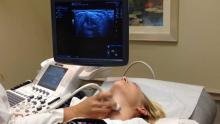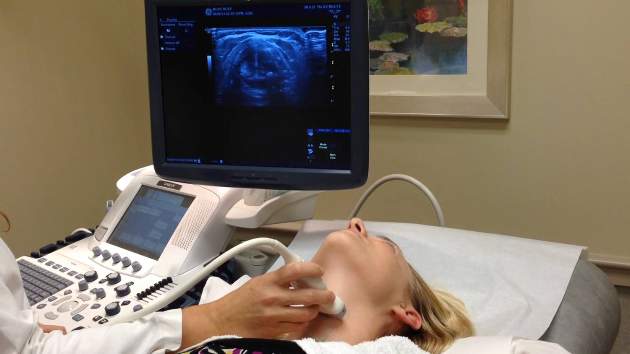User login
Laryngoscopy of vocal cords avoided with ultrasound
In candidates for thyroid surgery, ultrasound is an effective and convenient method of preoperative vocal cord evaluation, avoiding the costs of laryngoscopy, according to data derived from a retrospective study presented at the annual meeting of the American Association of Endocrine Surgeons in Nashville, Tenn.
In the study, which enrolled only those thyroid or parathyroid patients with risk factors for vocal cord paralysis, who would have been otherwise evaluated with flexible laryngoscopy, vocal cord ultrasonography (VCUS) proved to be an adequate examination in 76%, reported Dr. Denise Carneiro-Pla of the division of oncologic and endocrine surgery at the Medical University of South Carolina, Charleston.
The results have been practice-changing, she said. In thyroid or parathyroid surgical candidates at risk for vocal cord paralysis, flexible laryngoscopy had been the standard of care. When VCUS is adequate for visualization, it permits patients to avoid a separate office visit and an invasive procedure that many experience as uncomfortable. Based on data from this study, cost savings are substantial.
In patients scheduled for thyroid or parathyroid surgery, “ultrasound evaluation is already a routine part of the evaluation,” Dr. Carneiro-Pla explained. An evaluation of the vocal cords is easily performed at the same time, and visualization is typically adequate.
“You either have good visualization or you don’t,” she noted. “In the minority of cases when you do not, the patient can be referred for laryngoscopy.”
This assertion was supported by her study, which included a total of 194 consecutive patients from three institutions who were scheduled for thyroid or parathyroid surgery and had an indication for preoperative evaluation of vocal cord mobility. These indications included previous cervical procedures, a large goiter, significant hoarseness, and thyroid cancer suspected of possible extrathyroidal extension. All patients underwent VCUS, but 52 underwent flexible laryngoscopy regardless of the VCUS findings while 142 only underwent laryngoscopy if the VCUS was considered inadequate.
Overall, VCUS was judged to be adequate for evaluating vocal cord mobility in 164 (85%) of the total study population. In the group of patients for whom laryngoscopy was employed only if VCUS was not considered adequate, 24% did go on to the invasive procedure. The reasons were inadequate visualization in 11%, significant hoarseness despite normal VCUS in 8%, a finding of vocal cord weakness or paresis on VCUS that required further evaluation in 4%, and a surgeon decision or another reason in 1%.
In a comparison to those with adequate VCUS visualization, those without were, on average, older by 4 years and more likely to be male than female. Those with thyroid cartilage calcification were substantially less likely to have adequate visualization on VCUS than those without (57% vs. 92%; P < 0.005). Body mass index did not influence the adequacy of VCUS.
In patients at risk of vocal cord paralysis, Dr. Carneiro-Pla explained that some form of preoperative evaluation is considered essential to reduce the risk of a recurrent laryngeal nerve injury. Several previous studies have suggested that VCUS is accurate for predicting vocal cord paralysis, and this study reinforced this approach in routine patient care.
“An ultrasound evaluation would be performed in most patients anyway, so this avoids an extra step,” said Dr. Carneiro-Pla, whose study included a cost analysis that projected savings for the study group ranging from nearly $8,000 to more than $20,000.
She reported no relevant financial conflicts.
In candidates for thyroid surgery, ultrasound is an effective and convenient method of preoperative vocal cord evaluation, avoiding the costs of laryngoscopy, according to data derived from a retrospective study presented at the annual meeting of the American Association of Endocrine Surgeons in Nashville, Tenn.
In the study, which enrolled only those thyroid or parathyroid patients with risk factors for vocal cord paralysis, who would have been otherwise evaluated with flexible laryngoscopy, vocal cord ultrasonography (VCUS) proved to be an adequate examination in 76%, reported Dr. Denise Carneiro-Pla of the division of oncologic and endocrine surgery at the Medical University of South Carolina, Charleston.
The results have been practice-changing, she said. In thyroid or parathyroid surgical candidates at risk for vocal cord paralysis, flexible laryngoscopy had been the standard of care. When VCUS is adequate for visualization, it permits patients to avoid a separate office visit and an invasive procedure that many experience as uncomfortable. Based on data from this study, cost savings are substantial.
In patients scheduled for thyroid or parathyroid surgery, “ultrasound evaluation is already a routine part of the evaluation,” Dr. Carneiro-Pla explained. An evaluation of the vocal cords is easily performed at the same time, and visualization is typically adequate.
“You either have good visualization or you don’t,” she noted. “In the minority of cases when you do not, the patient can be referred for laryngoscopy.”
This assertion was supported by her study, which included a total of 194 consecutive patients from three institutions who were scheduled for thyroid or parathyroid surgery and had an indication for preoperative evaluation of vocal cord mobility. These indications included previous cervical procedures, a large goiter, significant hoarseness, and thyroid cancer suspected of possible extrathyroidal extension. All patients underwent VCUS, but 52 underwent flexible laryngoscopy regardless of the VCUS findings while 142 only underwent laryngoscopy if the VCUS was considered inadequate.
Overall, VCUS was judged to be adequate for evaluating vocal cord mobility in 164 (85%) of the total study population. In the group of patients for whom laryngoscopy was employed only if VCUS was not considered adequate, 24% did go on to the invasive procedure. The reasons were inadequate visualization in 11%, significant hoarseness despite normal VCUS in 8%, a finding of vocal cord weakness or paresis on VCUS that required further evaluation in 4%, and a surgeon decision or another reason in 1%.
In a comparison to those with adequate VCUS visualization, those without were, on average, older by 4 years and more likely to be male than female. Those with thyroid cartilage calcification were substantially less likely to have adequate visualization on VCUS than those without (57% vs. 92%; P < 0.005). Body mass index did not influence the adequacy of VCUS.
In patients at risk of vocal cord paralysis, Dr. Carneiro-Pla explained that some form of preoperative evaluation is considered essential to reduce the risk of a recurrent laryngeal nerve injury. Several previous studies have suggested that VCUS is accurate for predicting vocal cord paralysis, and this study reinforced this approach in routine patient care.
“An ultrasound evaluation would be performed in most patients anyway, so this avoids an extra step,” said Dr. Carneiro-Pla, whose study included a cost analysis that projected savings for the study group ranging from nearly $8,000 to more than $20,000.
She reported no relevant financial conflicts.
In candidates for thyroid surgery, ultrasound is an effective and convenient method of preoperative vocal cord evaluation, avoiding the costs of laryngoscopy, according to data derived from a retrospective study presented at the annual meeting of the American Association of Endocrine Surgeons in Nashville, Tenn.
In the study, which enrolled only those thyroid or parathyroid patients with risk factors for vocal cord paralysis, who would have been otherwise evaluated with flexible laryngoscopy, vocal cord ultrasonography (VCUS) proved to be an adequate examination in 76%, reported Dr. Denise Carneiro-Pla of the division of oncologic and endocrine surgery at the Medical University of South Carolina, Charleston.
The results have been practice-changing, she said. In thyroid or parathyroid surgical candidates at risk for vocal cord paralysis, flexible laryngoscopy had been the standard of care. When VCUS is adequate for visualization, it permits patients to avoid a separate office visit and an invasive procedure that many experience as uncomfortable. Based on data from this study, cost savings are substantial.
In patients scheduled for thyroid or parathyroid surgery, “ultrasound evaluation is already a routine part of the evaluation,” Dr. Carneiro-Pla explained. An evaluation of the vocal cords is easily performed at the same time, and visualization is typically adequate.
“You either have good visualization or you don’t,” she noted. “In the minority of cases when you do not, the patient can be referred for laryngoscopy.”
This assertion was supported by her study, which included a total of 194 consecutive patients from three institutions who were scheduled for thyroid or parathyroid surgery and had an indication for preoperative evaluation of vocal cord mobility. These indications included previous cervical procedures, a large goiter, significant hoarseness, and thyroid cancer suspected of possible extrathyroidal extension. All patients underwent VCUS, but 52 underwent flexible laryngoscopy regardless of the VCUS findings while 142 only underwent laryngoscopy if the VCUS was considered inadequate.
Overall, VCUS was judged to be adequate for evaluating vocal cord mobility in 164 (85%) of the total study population. In the group of patients for whom laryngoscopy was employed only if VCUS was not considered adequate, 24% did go on to the invasive procedure. The reasons were inadequate visualization in 11%, significant hoarseness despite normal VCUS in 8%, a finding of vocal cord weakness or paresis on VCUS that required further evaluation in 4%, and a surgeon decision or another reason in 1%.
In a comparison to those with adequate VCUS visualization, those without were, on average, older by 4 years and more likely to be male than female. Those with thyroid cartilage calcification were substantially less likely to have adequate visualization on VCUS than those without (57% vs. 92%; P < 0.005). Body mass index did not influence the adequacy of VCUS.
In patients at risk of vocal cord paralysis, Dr. Carneiro-Pla explained that some form of preoperative evaluation is considered essential to reduce the risk of a recurrent laryngeal nerve injury. Several previous studies have suggested that VCUS is accurate for predicting vocal cord paralysis, and this study reinforced this approach in routine patient care.
“An ultrasound evaluation would be performed in most patients anyway, so this avoids an extra step,” said Dr. Carneiro-Pla, whose study included a cost analysis that projected savings for the study group ranging from nearly $8,000 to more than $20,000.
She reported no relevant financial conflicts.
FROM AAES 2015
Key clinical point: If evaluated with ultrasound, surgery patients at risk for vocal cord paralysis can forgo preoperative laryngoscopy.
Major finding: Of candidates for laryngoscopy, 76% avoided this invasive procedure with ultrasound.
Data source: Review of prospectively collected data.
Disclosures: Dr. Carneiro-Pla reported no relevant financial conflicts.

